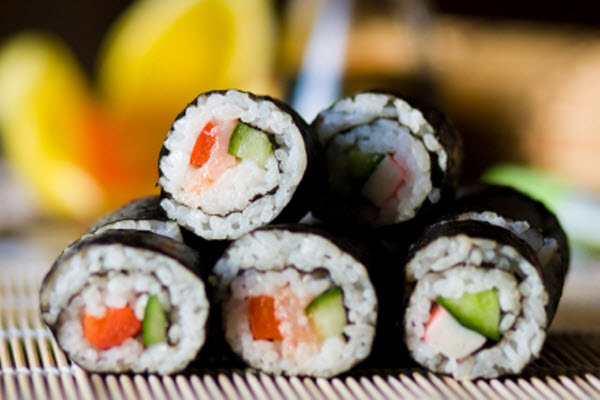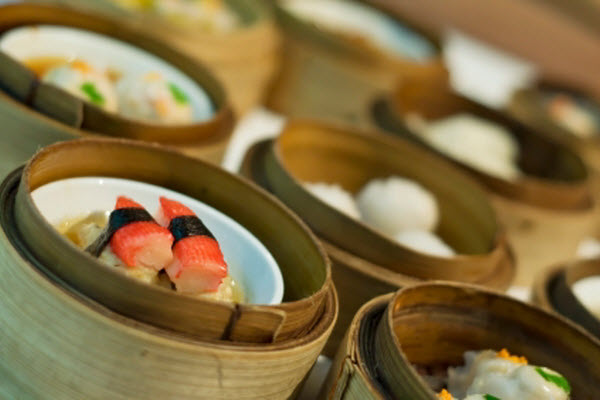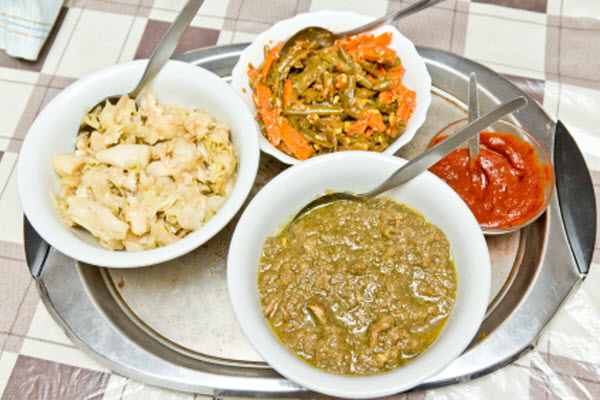
This is the fourth article in a series; see also: Cooking with Kids, Create a Kids’ Tasting Menu, and Get Out and Explore.
Trying different ethnic cuisines is an easy way to introduce kids to new kinds of food and to expose them to another culture’s language, smells, and décor (even if it’s 1970s Restaurant Style). Experiencing another culture’s food also helps expand a kid’s definition of “food.” For example, our local Taiwanese place serves jellyfish — we don’t expect our daughter to eat it, but it’s a good idea for her to know that people eat all kinds of things.
I was lucky to spend time in New York City and Miami as a child. These are great eating towns, mainly due to the wide availability of ethnic food. Eating Puerto Rican-Chinese food as a small child did a lot to seal the deal on my future food obsessions and sense of culinary adventurousness. I wanted to do the same for my daughter, so by the age of 2, she had eaten Japanese, Korean, Thai, Chinese, Salvadoran, Mexican, Puerto Rican, and Ethiopian food. None of the food we gave her was particularly challenging, but by exposing her early to what we like to eat she is now more willing to try different foods.
The Seattle area has a wide variety of ethnic restaurants to try, but you can also get into the ethnic zone by cooking at home. Like any other adventurous eating project, your kids might not take to it overnight, but repeated exposure helps. (Disclaimer: Lest anyone think my kid is some kind of poster child for adventurous eating, rest assured that she’s a medium-level eater. She’s annoyingly picky and vegetable-resistant like the rest of them.)
Here are some ideas for introducing your kid to ethnic food, by culture. Note that the restaurants I mention are just a suggestion. It’s all a matter of taste, so explore different places until you find your favorites.

Japanese Food
One of the world’s great cuisines, Japanese food is simple yet sublime, relatively healthy, and fun to eat. It also features great variety and is not just about sushi. (Unfortunately, it can also be quite expensive.)
- What to order: If you’re trying sushi, most kids will eat avocado, cucumber, and smoked salmon rolls. Branch out with fresh salmon, unagi (cooked eel), tamago (egg omelette), or shrimp tempura. (Avoid tuna because it contains a lot of mercury.) If your kids like noodles, try the udon, ramen, or sukiyaki. Agadashi tofu is also an easy win and is a good dish for introducing the flavors of ginger and daikon. If your kid wants cooked fish, try a salmon teriyaki or a broiled gindara kama (cod collar).
- Where to go: On the north end, we like the laid back atmosphere of Kozue in Wallingford for quality and price and the varied menu. When downtown we go to Fuji for family friendliness. In West Seattle, Mashiko has less traditional fare and a dedication to sustainability. Samurai Noodle in the University District is a fun place to try ramen. Conveyor-belt sushi, like Tengu in Northgate, is a quick, fun, and more affordable way to try sushi, but do splurge at some point with higher-end sushi, like Kisaku or Sushi Kappo Tamura.
- Trying it at home: Although some special equipment is required for Japanese cooking, sushi itself is easy and fun to make with kids. We use smoked salmon and avocado for the kids’ rolls and fresh sushi-grade tuna for the adults, but you can put any kind of veggie or cooked meat or fish with sushi rice inside a nori wrapper. Or try a ramen soup, which is quite easy to make once you have the ingredients.

Korean Food
A lot of Korean food is spicy and most of us are not as familiar with it. But the flavors are very intriguing and it’s worth the effort to step out of the comfort zone and try it.
- What to order: Most kids will happily down sizzling beef short ribs (kalbi) or chicken (dak kalbi), a big bowl of meat and veggies with rice (bibimbap, bee-bim-bop), or chive pancakes (buchu jeon), which are greasy but can do wonders for getting kids over onion aversion. Korean meals also come with a wide selection of little tiny dishes (banchan) filled with an ever-changing assortment of interesting nibbles, ranging from very spicy kimchi (fermented cabbage) to mild salted black beans.
- Where to go: Most of the great Korean food is found north of the city in Shoreline and Lynnwood or on the south end in Federal Way and Renton. There are a few decent places in the U District, but they are typically loud and full of frenetic crowds of students, so not very kid-friendly. We like Han Kang in Lynnwood. It’s near the fabulous Lynnwood Pool, so go and make a day of it!
- Trying it at home: I’m pretty new to Korean food so haven’t made anything beyond bibimbap. If you have a preschooler, check out Linda Sue Park’s children’s book, Bee-bim Bop! She includes a recipe with the book, which I made with my daughter after reading the book.

Chinese Food
Most Americans are familiar with standard Chinese food so I won’t cover it. But for a change of pace, try a dim sum meal — children love dumplings and will eat things they might not normally eat (like shrimp) when they are wrapped up in a steamed bun. Here’s a great overview of dim sum.
- What to order: Dim sum can feel overwhelming. Waiters wheel carts around with small plates and steamer baskets that they basically try to sell you by opening them and shoving them onto the table. So keep your wits about you and say no if you don’t want it. Try to pace yourself, too, or you’ll spend the rest of the day in a partial food coma. The best thing about dim sum is that the dishes are shared family-style so the kids can try lots of different things, including the shrimp buns, BBQ pork buns, shumai, spareribs, and meatballs.
- Where to go: All dim sum restaurants have their legions of boosters and detractors. According to the blogs and reviews, Seattle doesn’t have the best dim sum as a rule, but in the spirit of adventure you can try Jade Garden in the International District. Din Tai Fung and Noble Court in Bellevue are good. Expect long waits for any dim sum on weekends.
- Trying it at home: Unless you know someone who can show you how to make dim sum dishes, I would skip it. It takes hours of time and skill to make most of them. I spent three hours trying to replicate shrimp rolls and my daughter said, “This isn’t right! I’m not eating it.” Why bother when there are restaurants out there to do it for you?

Ethiopian Food
African food is not well represented in American cuisine, but Ethiopian food is getting more popular, especially with vegetarians, because it’s absolutely delicious. It’s also fun for kids because they get to eat it with their hands.
- What to order: Order a veggie combo so the kids can try all the different forms of lentils that are featured in this cuisine. The veggie combo usually includes yellow split peas, huge hunks of potato and carrot with cabbage, collard greens, red lentil stew, and lentil puree. Most restaurants will add some hard-boiled eggs on request. The kids get to rip pieces of the crepe-like injera bread with their hands and scoop up the lentils and veggies, which provides built-in entertainment. The kids should avoid the salad greens, which are typically laced with jalapeños. Likewise, the meat dishes are usually too spicy for young kids. For toddlers, you can order the Ethiopian version of oatmeal called kinche.
- Where to go: Everyone I know has a favorite Ethiopian restaurant. My neighbors, who hail from Ethiopia, recommend Meskel and Chef Cafe downtown, or Lucy in Oaktree Plaza. We enjoy Jebena Café and Enat in Northgate/Lake City.
- Trying it at home: When I first started eating Ethiopian food, it was nearly impossible to get decent recipes for it anywhere. But now, recipes on the Internet abound and most are fairly easy to make, particularly the lentils and greens. You can buy injera and the essential berbere spice at Ethiopian markets all over town. Given the amount of work involved in preparing Ethiopian dishes, I’d recommend you just head to a restaurant.

Thai Food
Another of the world’s great cuisines, Thai food is haunting, complex, and full of regional variation. It is also incredibly spicy, but most Thai restaurants are pretty good about lowering the spice level for kids based on a spice star system. As the kids get more adventurous you can up the spice level.
- What to order: Of course, there is Pad Thai, which is very popular for a reason. What’s not to like about noodles stir-fried with meat or tofu? Branch out by trying Pud Siew (stir-fried wide noodles), Tom Kha Gai (coconut milk and chicken soup) with rice, or steamed salmon with ginger. Older children who can tolerate some spiciness might enjoy comparing the different types of curry (red, yellow, green).
- Where to go: We just head to our neighborhood joint, Thai One On, in Lake City when we want Thai food. It’s not terribly “authentic,” but has a good neighborhood vibe. I’ve had decent Thai food at Orrapin in Queen Anne, Buddha Ruska in West Seattle, and Jai Thai in Fremont. The quality of Thai food varies greatly, so try a few different places.
- Trying it at home: I cook Thai food fairly regularly. Once you have the ingredients and a couple of techniques, it’s pretty straightforward, though admittedly time-consuming. The real barrier is that it’s nearly impossible to get a wok hot enough at home to produce the desired caramelization that happens in a restaurant. But, it’s still fun and rewarding to make at home. I highly recommend the cookbook, True Thai, by Victor Sodsook.

Vietnamese Food
Similar to Thai food but overall less spicy, though that depends on the region and who the restaurant is catering to. Like Thai food, Vietnamese food has something for everybody, with all the different noodles, soups, stir-fry, and grilled meats.
- What to order: Try the bún, which is a big bowl of grilled meat, seafood, or tofu with rice vermicelli noodles, bean sprouts, pickled carrots and daikon, and greens with a light fish sauce that you pour onto the bowl to your taste. You can also order the same ingredients on a platter and let the kids make their own lettuce wraps to dip into the sauce. The bahn mi is a sandwich version of basically the same stuff. There are also rice dishes, skewers of grilled meat and veggies, and rice noodle soups (pho), all of which are fantastic.
- Where to go: It seems like there is a pho place on every block in Seattle. Most of these places specialize in pho, but some also include a variety of other Vietnamese dishes. Up north we go to Pho Tic Tac, which has a full menu and a very fresh vegetarian pho. Tamarind Tree is more upscale and expensive, and doesn’t feel very kid-friendly, but has consistently good food. Vietnamese food is quite affordable in general so have some fun with the kids hitting a few different places to discover your favorite local place.
- Trying it at home: I haven’t cooked much Vietnamese food beyond making fresh rolls and pho. Making fresh rolls is a fun cooking activity to do with kids. You can add any type of filling, including some greens they might not normally eat, and the rice sheets are fascinating to use and touch.
See also:
How to Grow an Adventurous Eater, Part 1: Get Your Kids Cooking
How to Grow an Adventurous Eater, Part 2: Create a Kids’ Tasting Menu
How to Grow an Adventurous Eater, Part 3: Get Out and Explore
 Elise Gruber is a writer and project manager who grew up in Miami, where the eating of clams and conchs was considered normal. She loves to cook and think about food so is not enjoying the “beige food years” so much. In fact, she nearly burst into tears of joy when her kid yelled, “Mommy, I like beets now!” at the salad bar.
Elise Gruber is a writer and project manager who grew up in Miami, where the eating of clams and conchs was considered normal. She loves to cook and think about food so is not enjoying the “beige food years” so much. In fact, she nearly burst into tears of joy when her kid yelled, “Mommy, I like beets now!” at the salad bar.









